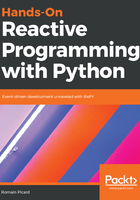
Reactivity diagrams
Fortunately, we can use diagrams inspired from a tool used in sequential programming: UML activity diagrams. An activity diagram is the UML name of something you may know as a flowchart. These diagrams are used to describe the sequences of actions which are performed by a program, but they can also express repetitions, alternatives, joins, merges and so on. Activity diagrams with only few tweaks are a great way to represent the behavior of an RX component. We will call them reactivity diagrams.
The main difference between an activity and a reactivity diagram is that an activity diagram represents actions that are performed when the component is called, while a reactivity diagram represents actions which are performed each time an item is emitted on one of the source observables. Other than that, the elements defined by UML are used in almost the same way. Let's detail this with the example shown in the following figure:

This is an example of a function which takes two observables as input and provides two observables as output. This function counts the number of dogs emitted on the Dogs input observable and sends back the name of all animals emitted on both the Dogs and Cats input observables. Input observables are observables that the component observes. They emit the items that will be transformed by the component. Input observables are represented as black circles. Output observables are observables that are the result of the transformation of the component. Output observables are represented as encircled black circles.
The previous example shows an important point in RX programming: from now on—almost—everything that you will write will deal with observables. It means that almost all components are written as functions that take observables as input and return observables. This is the way reusability is achieved via composition.
The same transformation is applied to the items of both input observables: capitalize the name of the animal. Then the capitalized dog name items are being shared; that is, they are being emitted on two observables. Finally, the capitalized dog name items are counted and the value of this count is emitted in the dogs count observable. On the right side, the dog and cat name observables are merged to an observable that emits the capitalized names of all animals.
So, if such a component is used with the following observables, it will be shown as in the following example:
dogs = Observable.from_(["sam", "max", "maggie", "buddy"])
cats = Observable.from_(["luna", "kitty", "jack")
It will emit the following items on the output observables:
dog_count: 1, 2, 3, 4
animals: sam, luna, max, maggie, buddy, kitty, jack
The actual ordering of the items emitted on the animals observable will depend on when they are emitted on the input observable.